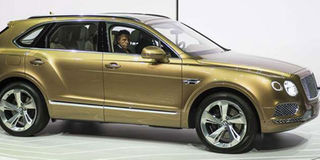The vehicles between town and country 4WDs

The luxury SUV Bentley Bentayga.The motoring world lacks a consistent definition of vehicles that cross and compromise the qualities of “town” cars and “country” 4WDs. The majority are misrepresented as SUVs (Sport Utility Vehicles). Perhaps because the balance of street and bush ingredients being fed into the design blender is extremely variable and still evolving. PHOTO | FILE
What you need to know:
- The adjective “utility” means useful, especially through being able to perform several functions. With equal force, it means “functional” – it exists to work, not to look pretty.
- Almost everything currently called an SUV lives in that void. Everything from a Nissan X-Trail to a 6 Series BMW, from a Honda CRV (Comfortable Recreational Vehicle) to a Range-Rover Evoque; from a Suzuki Vitara to a VW Touareg.
The motoring world lacks a consistent definition of vehicles that cross and compromise the qualities of “town” cars and “country” 4WDs.
The majority are misrepresented as SUVs (Sport Utility Vehicles). Perhaps because the balance of street and bush ingredients being fed into the design blender is extremely variable and still evolving. More likely because modern marketing is now such a pathological liar that anything as truth-centric as a definition is scary monster – to be rigorously repelled with smoke and mirrors.
Another reason is that America (quite a big vehicle market) still refuses in these matters to acknowledge a little place called “the rest of the world”. Further interference comes from attempts to defeat the role of vehicle “classification” as a controller of technical standards, road laws and, most especially, taxes.
To most of us the classification issues might be interesting in a stamp-collector or bird-watcher sort of way, but all we really want to know is what “type” a vehicle is, and we would like to have a universally meaningful word to describe it in conversation.
UTILITY VEHICLES
For about a century we have had a common comprehension of the phrase “passenger car”, and we broadly understand that it can be a saloon, a hatchback or a station wagon. Any vehicle based on one of these conventional passenger car platforms – with 4WD added – is known consistently (though not very meaningfully) as a “crossover”.
The Subaru, the Audi (Quattro) and the Volvo were probably the first. Now every make offers such a variant. But these options have not only proliferated but also evolved to the extent that many are no longer recognisable derivatives of an existing 2WD passenger car. They are their own thing.
They are crossovers that have now crossed, but the majority are not utility vehicles and nor are they fully-fledged 4WD estates
The adjective “utility” means useful, especially through being able to perform several functions. With equal force, it means “functional” – it exists to work, not to look pretty. Hence the phrase “Utility Vehicle” is already well embedded in motoring history as strictly functional working unit designed to carry a small load (of anything). We call them pick-ups. They may be single or double cab, and they may have any manner of open or closed box on the back. The original Jeeps and Land-Rovers of 75 years ago were, generically, 4WD utility vehicles.
So if 4WD is added to a pick-up platform, it would seem perfectly logical and legitimate to call it an SUV.
But that leaves us still waiting for a name for those predominantly road-going passenger cars with 4WD that are more than a crossover but less than a proper off-roader.
Almost everything currently called an SUV lives in that void. Everything from a Nissan X-Trail to a 6 Series BMW, from a Honda CRV (Comfortable Recreational Vehicle) to a Range-Rover Evoque; from a Suzuki Vitara to a VW Touareg.
That whole “type” of vehicle needs a collective name that does not include the word “utility”. Vox pop offers “up kerb” vehicles or “City Tractors”. Marketers need to beat those, or learn to live with them.





